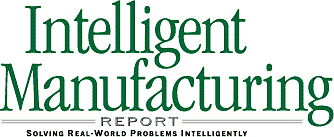
Intelligent Manufacturing € March € 1996 € Vol. 2 € No. 3

Intelligent Manufacturing € March € 1996 € Vol. 2
€ No. 3
The "Second Industrial Revolution" -- If you haven't already been
beaten over the head a few hundred times by this phrase, get used to
it because apparently it's been decided by those "in the know" that
manufacturers are perched on the threshold of a paradigm shift (to
use another well-worn cliché). The basic premise behind this
coming technological sea change is that software will replace
hardware as the driving force behind industrial automation.
More than 650 computer-integrated manufacturing (CIM) hardware and
software companies were gathered under several roofs earlier this
month at the CeBIT '96 show in Hannover, Germany, to stake their
claims in this Second Industrial Revolution. The CeBIT show is said
to be the industry's largest trade show, and with total attendance at
this year's event teetering close to 1 million (including exhibitors,
press and other assorted hangers-on), one would be hard put to argue
with that distinction. Not all of those impressive numbers can be
credited solely to manufacturing, of course; while an entire area of
the massive CeBIT campus was dedicated to CIM, an equal amount of
space was set aside for other computer-oriented technologies, such as
networking, office automation and telecommunications.
In the CIM arenas, rapid prototyping received the lion's share of
attention. Rapid prototyping is a procedure that helps manufacturers
reduce production times by creating components and finished products
as prototypes. CAD geometry data makes this possible via 3-D CAD
systems, as well as virtual manufacturing hardware and software. The
prototypes allow designers to assess the aesthetic and ergonomic
characteristics of a product, as well as its functional properties.
At CeBIT '96, exhibitors focused on some of the most important rapid
prototyping processes, such as systems for stereo lithography, fused
deposition modeling and 3-D printing.
Another CIM technology on display at CeBIT '96 was engineering data
management (EDM) systems. These systems have been developed as a tool
for integrated information and communications management, with the
goal of allowing manufacturing executives to manage and check data at
all company levels. The state-of-the-art with EDM systems features
client/server-based applications that combine all of the necessary
manufacturing data with no restrictions on time or place.
Closely related to EDM systems are product data management (PDM)
systems, which guarantee access to all of the information and
processes relevant to the product as well as the organization of this
data. PDM systems are designed to ensure a transparent and reliable
flow of information between all of the communication partners
involved.
Advent of the Information Society
According to Edith Cresson, a member of the European Commission, "It
is with good reason that commentators have spoken of a Second
Industrial Revolution. New information technologies are capable of
revolutionizing markets and human relations, as well as the
conditions of access to knowledge." She believes that, together with
the globalization of markets, "the advent of the information society
is the most powerful factor affecting the transformation of the
economy and society."
Cresson, whose remarks were part of the CeBIT '96 opening ceremonies,
went on to predict, "These new technologies will effect increasingly
profound changes in the organization and in the very nature of work
in the manufacturing industry. They are already creating a need for
new qualifications to address the problems encountered by users in
terms of the installation, maintenance and upgrading of
equipment."
The problem (there's always a problem), though, is that while
industrial automation can create new opportunities, it can also widen
the technological gaps between different countries. Cresson noted
that while 20 million computer users have access to the Internet and
the World Wide Web, hundreds of millions of people don't even have
access to a telephone. She advocates the institution of
"second-chance" schools throughout Europe, which would educate (or
reeducate, as the case may be) those whose skills are insufficient to
prepare them for another industrial revolution.
Given her position with the European Commission, Cresson also
analyzed the current state of R&D throughout Europe. CeBIT '96,
for instance, provided the first opportunity many Germans have had to
see and interact with the vendors of online access providers. While
28.8bps modems have been standard equipment in the U.S. for at least
a year, the German market is just now seeing the introduction of
14.4bps modems. Cresson lamented the steady loss of market share in
key leading-edge sectors throughout Europe over the past decade, and
urged a reduction in administrative red tape that could allow
entrepreneurs and technologists to bring new products to market more
quickly and easily.
Michael Rogowski, president of VDMA (Frankfurt, Germany), a
manufacturing trade association, sees Europe's industrial future as
being right now. "If we are speaking in terms of the national economy
and jobs," he said, "then the breakthrough for multimedia must come
in industry -- first and foremost in manufacturing." In mechanical
engineering, according to Rogowski, information technology processes,
controls and related software "are already integrated in
approximately 75% of all products."
Rogowski envisions a day of what he referred to as industrial
tele-work. "Just as the retail sector and banking have seized on
tele-shopping and tele-banking, manufacturing must also make better
use of the new possibilities:
In sum, he believes that "the advent of tele-work with all its
consequences for the workplace and employment - and indeed our daily
lives -- cannot be stopped." And whether you want to succumb to the
hyperbole of believing in a Second Industrial Revolution or not, the
evidence on hand at CeBIT '96 is that manufacturing software is just
as important as hardware these days, if not more so.